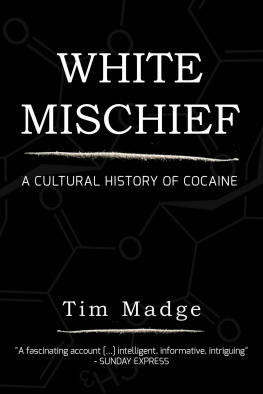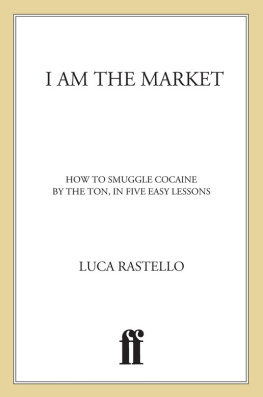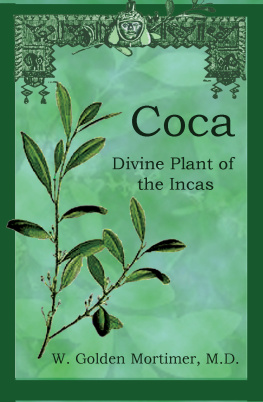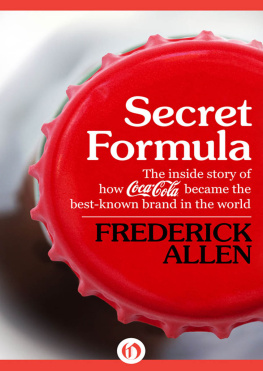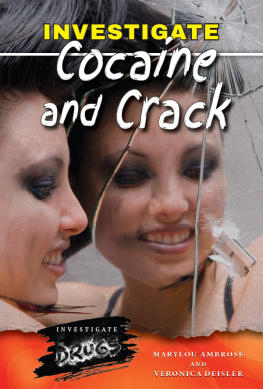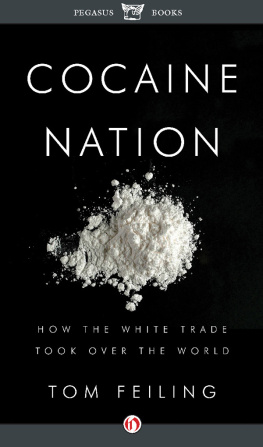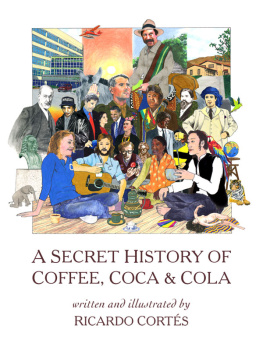WHITE MISCHIEF
A CULTURAL HISTORY OF COCAINE
Tim Madge
Tim Madge 2001
Tim Madge has asserted his rights under the Copyright, Design and Patents Act, 1988, to be identified as the author of this work.
First published in 2001 by Mainstream Publishing (Edinburgh) Ltd.
This edition published in 2018 by Lume Books.
For Laura: for everything
Table of Contents
FOREWORD TO THE FIRST EDITION
ALTHOUGH THIS IS PRIMARILY A CULTURAL HISTORY of cocaine and its uses, I begin with the known early history of the plant, the leaves of which cocaine is extracted from - the coca plant, Erythroxylum coca . The coca plant is not merely the natural source of a very powerful drug. Chewing the leaves to get a mild high has been, and still is, an integral part of the lives of millions of people in South America. No one knows how this practice began, but the plant was famously revered by the Inca, who believed it had sacred origins. On those grounds, its use was limited for many hundreds of years. To gain a full understanding of the history of cocaine, we have to delve into the long-existing traditions of the Andeans. We must try to grasp what it is about the coca plant and its effects that finally led to nineteenth-century European chemists isolating the alkaloid they chose to call cocaine.
Coca leaves are used - with the cocaine content removed - in the world's most popular soft drink, Coca-Cola (from whence the name derives). Coca-Cola drew its inspiration from Vin Mariani, a popular mix of coca leaf and French wine of which millions of bottles were sold throughout the last half of the nineteenth century at a time when many believed that the coca leaf was a food of the gods. Much of the 'research' done at that time on the coca leaf may now be dismissed as amateurish dabbling, mixed as it was with travellers' tales from the south as well as much mythological hyperbole surrounding the Inca. The culmination of this craze was an extraordinary book written by W. Golden Mortimer, History of Coca , which is an anthem to the glory of the coca leaf more than anything else.
Today, anyone who has tried coca tea, or chewed coca leaves legally - in parts of South America will attest to the plant's powers, mild in one sense but definitely an effective pick-me-up. Much detailed research still needs to be done on the leaves, but evidence exists to suggest that the coca leaf is worthy of further study.
Cocaine, the heart of this story, has an altogether different history. Its impact on the past hundred or so years has been intermittent but startling. Cocaine has been understandably demonised more than once over the years. Its most recent manifestation - as a smokable drug - has caused more anguish and misinformation than most other drugs classed, as it is, among the most dangerous (or powerful, depending on your point of view) known to humankind. There are entire cultures associated with the use of cocaine, jet-setters and the poor of the ghetto being just two. These diverse cultures have emerged more in the past twenty years than in any other time since cocaine was first synthesised.
It is a drug that, from every point of view, seems set to be with us for a very long time. We need to understand more about cocaine, to contextualise it in history, to see the errors made in the past over handling it and the mistakes we are making now in terms of policy, supply and use. These mistakes come from all directions - from the authorities who would ostensibly rid the world of it, to the illegal jungle laboratories still expanding their supply and the millions of users who show no sign of reducing their own demand.
FOREWORD TO THE 2018 EDITION
Nigh on 20 years have passed since I wrote the words above. What, if anything, has changed? The answer is surprising, perhaps most of all with regard to the USA, the spiritual and legal home of the war on drugs which can be said to have begun a century ago, aimed directly at the British and their opium trade into China.
Today, in the USA, a large majority of states (41) have moved to legalise the use of marijuana (8), decriminalize use (13), or allow use for medical reasons (20). Where its use is legal, growing it is, too. Now marijuana is not cocaine of course, but some including this author would argue that some modified forms of the drug, like skunk or, in the UK, spice, are far more dangerous in both use and addiction. The biggest problem, urgently needing supervised research, is into mental health issues, particularly among the young.
One country Uruguay has legalized marijuana; Canada will legalise it late in 2018; Ghana has proposed to decriminalise it. Portugal has decriminalised all drug use (with drops in addiction and drug-related crime rates).
What of the UK? A 2014 survey by the Observer noted the following:
More than million Britons , nearly one in three of the adult population , have taken illegal drugs and the proportion of the nation who have ever taken drugs is increasing over time ; when the Observer last conducted research into national drug usage and attitudes in 2008 , % of the population had taken illegal drugs . That figure has now increased to %. Last time round we noted that , while men were more likely than women to take drugs , the gender gap appeared to be closing , based on a comparison between 2008 and 2002 data . That process is now complete , with both sexes equally likely to have taken drugs . Thirty - one per cent of those currently aged - have taken drugs but - - year - olds have been the biggest users of drugs with nearly half ( %) of this age group having taken them . Regionally , rates of drug taking peak in Scotland , where % have taken drugs .
Of this number, 29 per cent had taken cocaine. Of course, the highest percentage (93 per cent of drug users) had taken marijuana. The survey, incidentally, but importantly, found there was little evidence that marijuana was a gateway drug, that is, users would go on to other, harder drugs. Of other popular drugs, 25 per cent had used MDMA (Ecstasy), just six per cent heroin. The 22 per cent who had tried magic mushrooms, bizarrely in the UK, find themselves placed in the same category, legally, as those who use crack cocaine. Shurely shome mishtake?
The survey found that of the 15 million, 20 per cent said they were current users; 40 per cent were, as it quaintly put it, in the higher echelons of society. The I used to but dont any more reply, is a standard get out of gaol card in trying to establish the truth about drug use. More of that later.
Legally, in the UK, nothing has changed. Drug-taking, as well as supply and manufacture, remains illegal, carrying in many cases, the potential for high fines or imprisonment.
So, what does this mean? And how does this relate to cocaine, the subject of this book? First, that usage of the old stalwarts, marijuana, cocaine, heroin and MDMA (Ecstasy) continues unabated, while being supplemented by the addition of crystal meth and prescription drugs, (both of which have created an epidemic crisis in (largely) white America). Alongside these phenomena, has been the rise of so-called designer drugs, in attempts to circumvent existing laws, creating their own problems of addiction and potential mental and physical damage to users.
At the policy level, extremes manifest themselves. While the president of the Philippines boasts of, in effect, extra-judicial killing of drug dealers, in the USA, prior bastion of probity when it came to cracking down on illicit drug use, as noted eight states have legalised marijuana growing, supply and use. In the UK, the law on marijuana is increasingly obeyed in the breach.
Most noticeably, and depressingly, a serious, well-organised and conducted debate about the so-called heavy drugs, cocaine and heroin, their use and possible licencing- at least - is buried under the same moral panic I discuss in the following pages. Plus ca change or is it?
Next page
